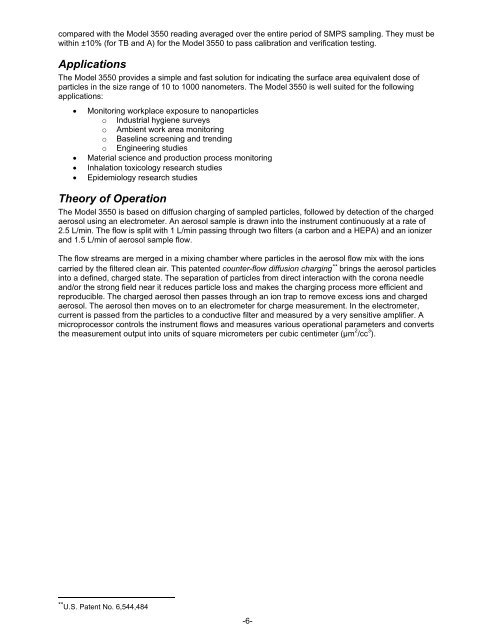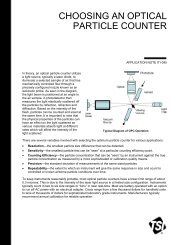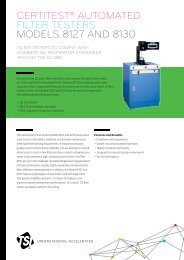Measuring Nanoparticle Exposure - Application Note NSAM-001 - TSI
Measuring Nanoparticle Exposure - Application Note NSAM-001 - TSI
Measuring Nanoparticle Exposure - Application Note NSAM-001 - TSI
You also want an ePaper? Increase the reach of your titles
YUMPU automatically turns print PDFs into web optimized ePapers that Google loves.
compared with the Model 3550 reading averaged over the entire period of SMPS sampling. They must be<br />
within ±10% (for TB and A) for the Model 3550 to pass calibration and verification testing.<br />
<strong>Application</strong>s<br />
The Model 3550 provides a simple and fast solution for indicating the surface area equivalent dose of<br />
particles in the size range of 10 to 1000 nanometers. The Model 3550 is well suited for the following<br />
applications:<br />
• Monitoring workplace exposure to nanoparticles<br />
o Industrial hygiene surveys<br />
o Ambient work area monitoring<br />
o Baseline screening and trending<br />
o Engineering studies<br />
• Material science and production process monitoring<br />
• Inhalation toxicology research studies<br />
• Epidemiology research studies<br />
Theory of Operation<br />
The Model 3550 is based on diffusion charging of sampled particles, followed by detection of the charged<br />
aerosol using an electrometer. An aerosol sample is drawn into the instrument continuously at a rate of<br />
2.5 L/min. The flow is split with 1 L/min passing through two filters (a carbon and a HEPA) and an ionizer<br />
and 1.5 L/min of aerosol sample flow.<br />
The flow streams are merged in a mixing chamber where particles in the aerosol flow mix with the ions<br />
carried by the filtered clean air. This patented counter-flow diffusion charging ** brings the aerosol particles<br />
into a defined, charged state. The separation of particles from direct interaction with the corona needle<br />
and/or the strong field near it reduces particle loss and makes the charging process more efficient and<br />
reproducible. The charged aerosol then passes through an ion trap to remove excess ions and charged<br />
aerosol. The aerosol then moves on to an electrometer for charge measurement. In the electrometer,<br />
current is passed from the particles to a conductive filter and measured by a very sensitive amplifier. A<br />
microprocessor controls the instrument flows and measures various operational parameters and converts<br />
the measurement output into units of square micrometers per cubic centimeter (µm 2 /cc 3 ).<br />
** U.S. Patent No. 6,544,484<br />
-6-




